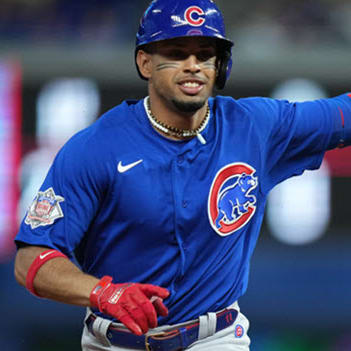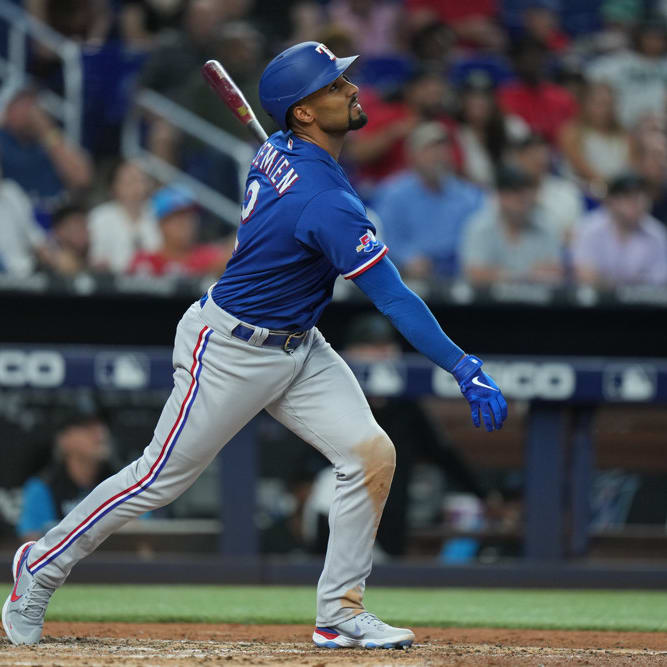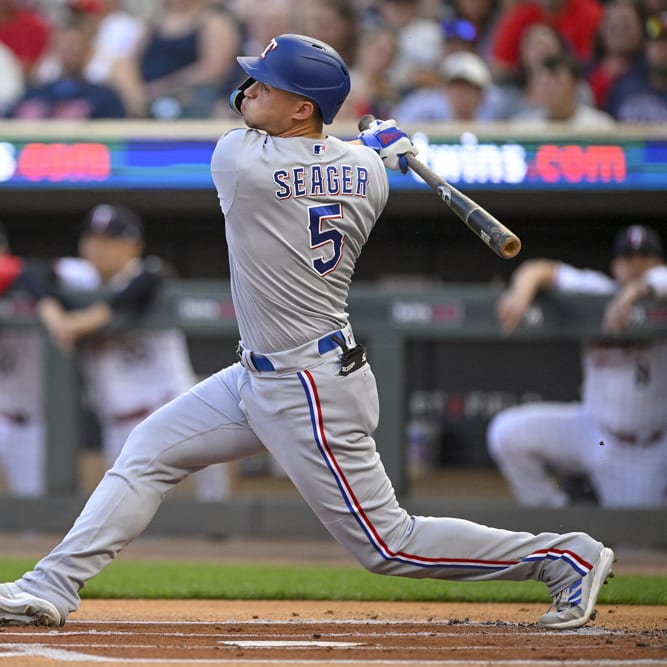This article is part of our Bogfella's Notebook series.
For almost 25 years, pitching guru Brad "Bogfella" Johnson has provided insightful evaluation and analysis of pitchers to a wide variety of fantasy baseball websites and publications while also appearing as a guest analyst on fantasy baseball webcasts and radio broadcasts. Over the years, "Bogfella" has become best known for leading the way in identifying pitchers who are poised to provide excellent value.
Let's jump right in ...
This Week's Scouting Tip: It's Not All Hit or Miss
Recently we talked about watching the catcher while evaluating a pitcher. We'll take it a bit further this week and we'll focus on watching the batter. It's not too difficult to define a pitcher's upside when he is consistently generating a lot of swinging strikes, and it's equally easy to become concerned when your guy is getting hammered for line drive after line drive into the gaps or over the wall. However, there are more discreet signs to watch for, and that is the topic for this week's scouting tip. What can you take away from the reactions of hitters facing the pitcher you are trying to evaluate?
Some examples:
Foul Balls, Knee Bucklers, and Letting One Go ...
There are many things you can consider when watching a hitter in the batter's box. One example is, amazingly enough, foul balls. There is a significant difference in a long flyball down the line but foul, and a pitch fouled straight back into the screen. They both provide an indication of the batter's
For almost 25 years, pitching guru Brad "Bogfella" Johnson has provided insightful evaluation and analysis of pitchers to a wide variety of fantasy baseball websites and publications while also appearing as a guest analyst on fantasy baseball webcasts and radio broadcasts. Over the years, "Bogfella" has become best known for leading the way in identifying pitchers who are poised to provide excellent value.
Let's jump right in ...
This Week's Scouting Tip: It's Not All Hit or Miss
Recently we talked about watching the catcher while evaluating a pitcher. We'll take it a bit further this week and we'll focus on watching the batter. It's not too difficult to define a pitcher's upside when he is consistently generating a lot of swinging strikes, and it's equally easy to become concerned when your guy is getting hammered for line drive after line drive into the gaps or over the wall. However, there are more discreet signs to watch for, and that is the topic for this week's scouting tip. What can you take away from the reactions of hitters facing the pitcher you are trying to evaluate?
Some examples:
Foul Balls, Knee Bucklers, and Letting One Go ...
There are many things you can consider when watching a hitter in the batter's box. One example is, amazingly enough, foul balls. There is a significant difference in a long flyball down the line but foul, and a pitch fouled straight back into the screen. They both provide an indication of the batter's ability to judge the speed of the pitch. Being way out in front (overestimating the speed of the pitch) often ends up in a foul ball down the line to hitter's batting side while being late (underestimating the speed) is more likely to send the ball into foul territory to the other side of the field. In both cases, the pitcher managed to fool the hitter - either by throwing an unexpected pitch or effectively changing speeds. Far more dangerous is the foul straight back. That suggests the hitter was anticipating the pitch and had it well timed. If it's happening often, there is a good chance that hitters will quit missing, and start hitting those pitches - too often, hitting them hard.
A couple of the best indicators of pitcher effectiveness are knee buckling or seemingly letting a good pitch to hit go by. When a hitter's back foot moves away from the plate, it suggests he was fooled by the delivery and did not expect the pitch to be in the strike zone. The result is usually a weak, poorly timed swing or a take. That's next on the list; letting a good hitter's pitch - something in or near the middle of the zone - go by can be a sign that the hitter was expecting a totally different pitch or a very different location. In either case the pitcher was able to "keep the hitter off balance" and the more frequently that happens, the more likely your pitcher will be to have ongoing success. Now for a critical tip in judging that ongoing success as it relates to "new" pitchers. MLB hitters adjust. The rookie pitcher who fools them early on can be studied, and if he doesn't also adjust, he will often turn into the "hot item" on the waiver wire that implodes just after you pick him up. You have to be sure he can fool hitters after they have seen him.
Here are some basic indicators of a pitcher's ability to fool hitters:
- Hitters talk about "seeing the ball" and they will consistently show you that they are or are not "seeing the ball" very well against any specific pitcher. Weak swings or taking strikes are the most obvious signs. A hitter who is not picking up the pitches, or not recognizing the rotation of the ball will invariably look uncomfortable at the plate. Obviously, the better the hitter overall, the more telling it is when a pitcher is almost always fooling him.
- Pitchers with good command of several pitches will often "save" a pitch or two for use later in the game. It's part of their adjustment. If the hitter saw (and perhaps timed) their fastball in his first at bat, switching to a steady offering or breaking or offspeed pitches can keep that hitter off balance later in the game. This is a key concern for pitchers who only have one or two reliable pitches. They are generally less effective as the game wears on. You need to look for the use of at least three or even four pitches over the course of a game.
- Watch the timing of a hitter's swings. A long flyball that is way foul may draw oohs and aahs from the crowd, but the hitter was actually fooled by the pitch and the advantage usually still belongs to the pitcher. When they foul a pitch straight back with a wicked swing, more often than not the hitter was ready and simply missed their chance. Hopefully, your guy will change speeds or location - soon.
- Beware the guy we will call "flavor of the month." You know the one, he's baffling over a handful of 5-6 inning starts, and he becomes the waiver wire sweetheart. You grab him, and he instantly implodes with a few disaster starts before landing back in Triple-A. This is the adjustment process. Hitters haven't learned yet. They see him a couple of times in a game and then he's gone. But, the word circulates quickly. He lacks confidence in his offspeed pitches, or he can't consistently throw strikes with his breaking pitches. Those "off balance" hitters start teeing off.
Now, let's check this week's Scouting Notebook ...
This week begins our regular weekly feature of scouting pitchers of interest. Who should you watch? Who is showing promise, and who is waving red flags? Each week we will target specific games and provide readers with an analysis of key pitchers in those games. Alright, let's get started:
Clayton Kershaw (LAD)vs. SF- There's probably not a lot room to move Kershaw much higher on most target sheets, but he is ready to step up to the next level. And, that level would be an "elite" fantasy pitcher, one to be considered in the same strata as Roy Halladay, King Felix, and this week's opposing pitcher, Tim Lincecum.
Kershaw has a devastating slider that he uses more often than his equally devastating curve. He has plenty of movement on his fastball, keeps the ball in the park, and misses a lot of bats. He still needs to bring his walk rate down a bit, but that has been steadily improving. In his season debut, all of these things came together in a dominating performance where Kershaw out-dueled Lincecum in a classic matchup. Without question, the first thing you should make note of regarding this start was his confidence in his entire repertoire. He was consistently ahead in the count which always helps, but he threw breaking pitches to spots even in fastball counts. With his stuff, hitters cannot afford to be guessing, and he kept them guessing throughout the game.
Kershaw tends to use his fastball to set up his breaking pitches. He has enough velocity to deny hitters the ability to sit on his curve and slider - if they do the fastball zips right on by. He changed speeds constantly against the Giants and consistently had hitters out on their front foot. And, with so much movement, those off balance wings often turned into swinging strikes. Like most young pitchers, he just needs to trust his stuff to avoid walks, or worse yet, high pitch counts. His performance this year will be directly tied to how deep he pitches into games. The deeper he goes, the better his chances to amass wins, and the higher his strikeout rate will climb.
He is no secret now, but draft day 2011 might have been your last chance to get him at even a modest discount. In fact, he is as good a bet as any NL hurler to capture this year's Cy Young award - quite possibly his first of several if he stays healthy.
Jeff Francis (KC)vs. LAA - Unlike Kershaw, Jeff Francis does not have overwhelming stuff. Earlier in his career, before the long list of injuries, his fastball barely broke 90, and something in the high 80's is the norm these days. However, Francis is a prime example of that pitcher who can be successful without a blazing fastball.
In his start against the Angels, Francis served up a first-inning HR to Howie Kendrick and then settled into a pitcher's duel with Dan Haren. Along the way, he threw 63 of 99 pitches for strikes while inducing a 3:1 GB/FB ratio (12-4). He is not likely to be a high strikeout pitcher, but he did manage four whiffs. The key to this outing was his ability to change speeds, and that will continue to be a major indicator of his performance this season. His breaking pitches were crisp and consistently well-placed while his ability to throw strikes with roughly a 15-20 mph disparity in velocity (high 80's to low 70's) made it nearly impossible for hitters to time his delivery.
Francis gets by on pitching savvy. He works both sides of the plate and will occasionally work up and down as well. However, he is shrewd enough to keep the pitches he throws up to change the hitter's eye level out of the zone, and typically, in on the hitter's hands. Because he does not have a dominating fastball, hitters will have to look for the off speed stuff and hope they can adjust to his fastball. Free-swinging teams might struggle against him while more patient teams could have some success if they can force him to get more of the plate. Note how Bobby Abreu struggled against him in this game. Because he tried to look fastball, Francis was able to keep him off balance.
Given his mediocre strikeout rate, he will not be a front line fantasy starter, but pitching in Kansas City (certainly a step up from Colorado) could allow him to be a useful pitcher at the back of your rotation.
Kyle Drabek (TOR)vs. MIN - His debut late last season hinted at why the Jays wanted him as a key piece of the deal that sent Doc Halladay to Philadelphia. His first start of 2011 against the Minnesota Twins did nothing but reinforce those expectations.
Drabek, the son of former Cy Young winner Doug Drabek, held the Twins hitless through the first five innings before allowing a hit in the sixth, although he did give up a run earlier in the game prior to allowing that first hit. Drabek will need to be a bit more efficient with his pitches to advance his initial success as his pitch count was a bit high despite his overall effectiveness. A huge plus was his ability to keep the ball out of the air as 18 of the 21 outs he recorded were either ground balls (11) or strikeouts (7).
He features a 2-seam and a 4-seam fastball with mid 90's velocity, and he breaks out a nasty power curve when the situation calls for a punch out. More importantly, he has also added a cutter which he featured in the Twins game. In fact, it may have been his most devastating weapon as it moves away and drops against left-handed hitters. His ability to consistently handle left-handed swingers has been the most prominent concern regarding his readiness to perform at the MLB level, however if he can rely on that cutter like he did in his first start of the season, those doubts will quickly fade.
Given his experience level, Drabek will likely have his off days in 2011, but he has the upside to settle in as a #3 or #4 fantasy starter, perhaps as early as this season. With his outstanding first outing, he should now have a rotation spot locked down, so give him serious consideration if he is still available in your league. Keeper and dynasty owners may want to pursue him with even more zeal.
Some short takes:
Brian Matusz (BAL)- A strained intercostal muscle will keep him out, probably until early May, however this will likely only delay his breakout season so you might want to inquire as to his availability if his owner is prone to being impatient.
Fausto Carmona (CLE)- No starting pitcher has ever allowed 10 or more runs in less than 3 innings on opening day - until now. He really was that bad too. He reinforced our decision to suggest avoiding him based on a sinker that doesn't sink being a batting practice fastball - and he threw a lot of them.
James Shields (TB)- We expected him to bounce back this year after a forgettable 2010, and his start against Baltimore suggests he might be headed that way. He was on the black most of the game against a team that came out with some hot hitting. He is probably worth a spot in your rotation if you can get him cheap.
Jordan Walden (LAA) - Manager Mike Sciosia just named him the closer while Fernando Rodney will pitch in less critical roles, at least for now. Walden is the real deal and it was only a matter of time before this change took place. Obviously he will have to prove himself, but we expect Walden to step in and do well over the long term.
Craig Kimbrel (ATL)- The Braves were supposed to be using a committee to close this season, but the usage in their first game (Venters in the 8th despite primarily facing right-handed hitters and Kimbrel in the 9th with mostly lefties due up) suggested Kimbrel could be the guy until he shows he isn't up to it and the Braves have now confirmed that.
That's a wrap for this week, but for some of the most in-depth coverage of all things pitching in fantasy baseball for 2011, visit www.bogfella.com.










